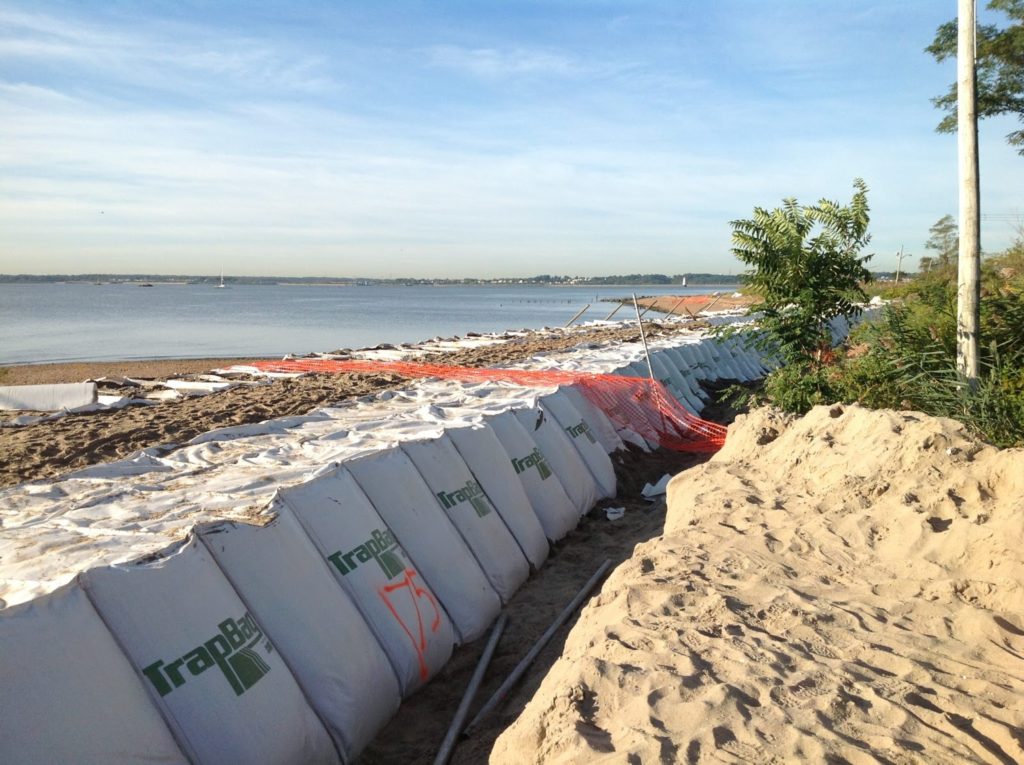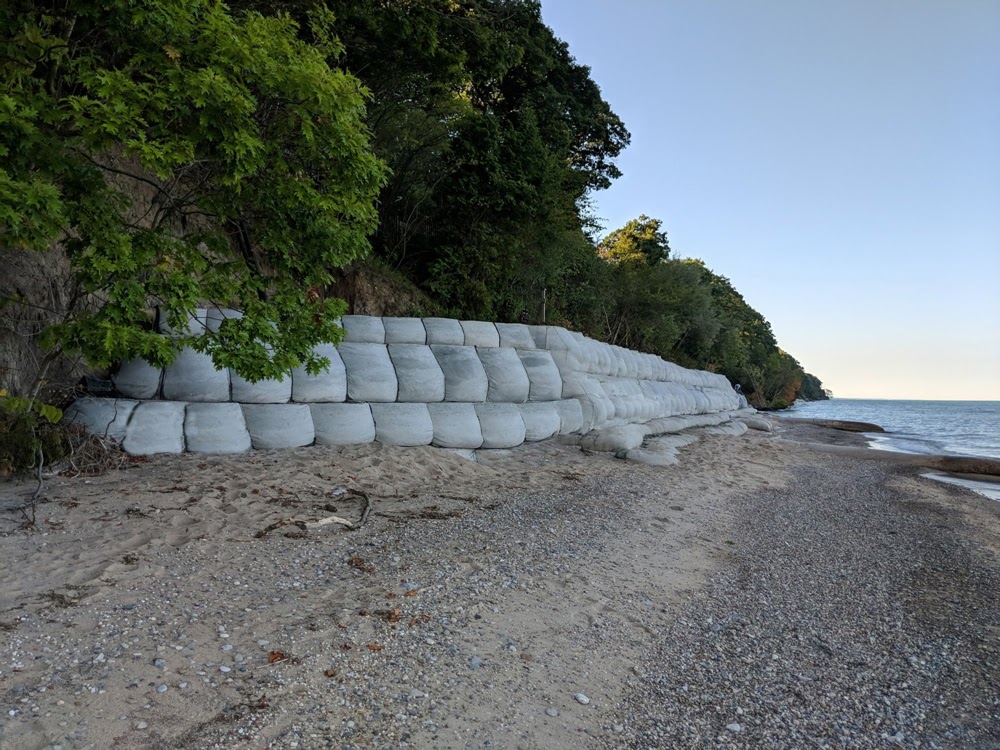Lake erosion is a consistent issue, that is caused by factors such as strong winds, rising water levels, and powerful waves. Beaches, shorelines, and coastal properties can experience considerable economic loss and environmental loss from shoreline erosion.
How Does Lake Erosion Work?
Lake erosion occurs when water, wind, and other natural elements wear away the lakeshore. Several factors can accelerate erosion, such as flooding, climate change, and land development near the water’s edge. Flooding increases the ability of water to erode the soil, climate change can lead to more extreme weather patterns, and development often removes natural barriers to erosion.
Understanding the dynamics of erosion and developing effective control methods are the keys to mitigating further damage, protecting valuable assets, and ensuring the long-term sustainability of your community.
How Erosion Can Impact Your Community
Unchecked erosion can wreak havoc on critical infrastructure near shorelines, such as roads, bridges, and buildings. It can also severely impact recreational activities like boating, fishing, and tourism, which are significant economic drivers for many coastal communities. By removing natural barriers, erosion can also increase the risk of flooding along the shoreline.
Beyond the economic implications, lake erosion can also have severe environmental consequences. Eroded shorelines can harm local wildlife habitats by disrupting delicate ecosystems and impacting biodiversity.
Effective Lake Erosion Control Methods
Vegetation
Vegetation is a powerful tool in stabilizing shorelines and mitigating lake erosion. By strategically planting native grasses, shrubs, and trees along the shoreline, a natural barrier can be established to fortify the soil and dissipate the energy of waves and runoff.
The root systems of carefully selected plants act as an anchor, binding the soil together and preventing it from being washed away by the forces of nature. Above ground, the dense foliage and sturdy stems create a buffer zone, absorbing the impact of waves and slowing the flow of water.
Fencing
Fencing is a popular temporary lake erosion control method. By strategically installing fences along the shoreline, a barrier is created that traps sediment and encourages the growth of stabilizing vegetation over time.
When implemented correctly, fencing can serve as a crucial first line of defense against erosion. The fences act as sediment traps, capturing and retaining soil and other materials that the relentless action of waves and currents would otherwise wash away. This not only helps to preserve the existing shoreline, but also facilitates the natural accumulation of sediment, gradually rebuilding eroded areas.
While fencing is an effective temporary measure, it is typically employed in conjunction with other long-term lake erosion control methods. By combining fencing with techniques such as vegetation establishment, geotextile barriers, or engineered solutions like TrapBag barriers, you can develop a comprehensive and sustainable approach to erosion mitigation.
Beach Nourishment
This approach involves replenishing eroded shorelines with sand or other compatible sediments to effectively restore lost beach areas and create a protective buffer against the water.
By strategically introducing new sediment to the shoreline, beach nourishment not only enhances the aesthetic appeal of the area but also provides a crucial line of defense against further erosion. The added sand or sediment acts as a barrier, absorbing the energy of incoming waves and protecting inland areas from the damaging effects of erosion.
Rip Raps
Rip raps, composed of carefully placed large, angular rocks, are strategically positioned along vulnerable shorelines to absorb and deflect incoming waves.
The effectiveness of rip rap barriers lies in their sheer mass and placement. Each rock is meticulously selected and positioned to create an interlocking barrier that dissipates the kinetic force of the waves.
TrapBag Barriers
TrapBags are used to create a customizable and cost-effective barrier system that conforms seamlessly to the contours of any shoreline for an effective lake erosion control method.
They can be used to facilitate the establishment and growth of native vegetation, protect local infrastructure, and create the basis of sand dunes or bank stabilization.

Why Choose TrapBag?
TrapBag offers a comprehensive solution that combines affordability and effectiveness with speed and convenience.
They are made from recyclable geotextile fabric and engineered in a pentagon shape that allows a wall of TrapBags to create an accordion-like structure in which each cell reinforces the next. Even if one TrapBag were to be compromised, the rest of the barrier would continue to hold up.
TrapBags can be filled with sand, washed gravel, and other materials that are less than two inches across. Their efficient design allows them to use 40% less fill material than sandbags, and far fewer TrapBags are needed to protect the same area against floodwaters. A single 100-foot section of four-foot-tall TrapBags can replace approximately 8,000 sandbags. They also have a lifespan of at least five years and have survived mudslides, hurricanes, storm surges, and plenty of other cases of extreme weather.
Whether you’re dealing with minor shoreline erosion or preparing for a major storm, TrapBag provides reliable protection.
Our Erosion Control Projects
TrapBags have been used to protect homes and businesses from erosion across the world. They stopped erosion from destroying a family cottage on Lake Michigan during record high water levels.
The construction team that deployed the TrapBag lake erosion control barriers estimated the cottage had just two weeks before the erosion damaged it beyond repair. Fortunately, TrapBags can be deployed within a matter of hours and provide a solid barrier against erosion.
TrapBags helped with a similar project in Chicago, in which local officials used the barriers to protect against flooding and erosion during storm season.
As the first major storm of the season struck, sinkholes and erosion threatened vital infrastructure, including the iconic South Shore Cultural Center and Arthur Ashe Beach Park. TrapBags were deployed to fill and reinforce compromised areas to keep residents and visitors safe while preserving the natural beauty of the lakefront.
Tell Us About Your Project
If you’re facing challenges with lake erosion, reach out to the team at TrapBag. Our expert staff will assess your situation and develop an erosion control solution that meets your needs.


